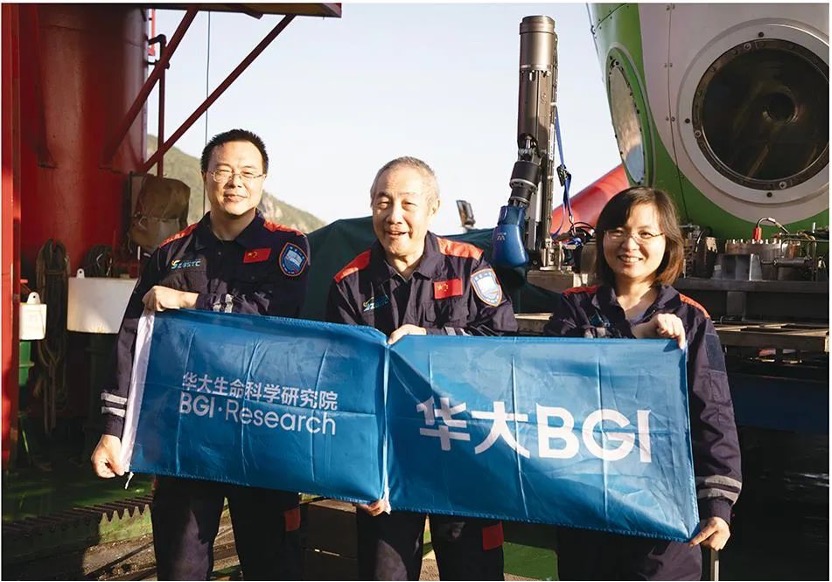Green, yellow, and orange—these were the glowing lights of bioluminescent creatures spotted more than 10,000 meters below the ocean’s surface. When the submersible’s lights switched on, they revealed “a profound and mysterious blue,” teeming with drifting plankton. This is the Mariana Trench, the deepest part of the Pacific Ocean, long believed to be a barren world.
However, recent discoveries have shattered this notion - the deep ocean is far more vibrant and thriving than previously imagined. On March 6, Cell published one commentary and three research articles as a cover story, systematically unveiling the ecological characteristics of the hadal zone, a cluster of deep-ocean habitats that plunge to depths of 6,000–11,000 m below sea level. These findings come from the Mariana Trench Environment and Ecology Research (MEER) Project, a collaboration launched in 2021 by BGI Group, the Institute of Deep-sea Science and Engineering (IDSSE) of the Chinese Academy of Sciences, Shanghai Jiao Tong University (SJTU), and other Chinese scientific institutions.
What secrets lie in the deepest part of the earth's surface? How can life not only survive but thrive in a place without a single ray of sunlight, under pressure that could crush a car, in near-freezing temperatures, and with nutrients scarce as in a desert? To answer these questions, we asked the authors from BGI Group to share the untold story of the deepest part of the ocean.
 A fish observed swimming in the deep sea during a deep dive exploration.
A fish observed swimming in the deep sea during a deep dive exploration.
Q: Which part of this study were you mainly responsible for? Did you come across anything interesting?
Han Mo (Senior Research and Development Engineer at BGI-Research):
My research focuses on the microbiome of hadal sediments, where I coordinate the optimization of research methods, design study protocols, draft and revise scientific papers.
One of the most fascinating discoveries I’ve made is that, despite the extreme conditions and the limited resource, microorganisms have evolved diverse survival strategies. Some say, “life finds a way,” but we argue that life finds more than one way - even in the harshest environments. This realization has been both inspiring and thought-provoking for me.
Being part of this project has been challenging, but that’s the nature of scientific research - you must be prepared to embrace the grind and, more importantly, learn to find joy in it.
Meng Liang (Associate Researcher in Biotechnology of BGI-Research):
My focus is on the genome sequencing of the amphipod Hirondellea gigas (H. gigas) - one of the most ubiquitous and abundant scavenging amphipods in hadal trenches - and studying its adaptations to hadal environments.
But I have to admit, this project has been incredibly challenging. There were hardly any fun moments - only plenty of struggles and hard-earned progress.
The biggest hurdle is that H. gigas live at depths close to or even exceeding 10,000 meters. The drastic changes in pressure and temperature during sampling made it nearly impossible to obtain high-quality DNA suitable for single-molecule long-read sequencing in the lab. It took us two months just to overcome the challenge of extracting long-fragment DNA before sequencing could even begin.
And that was only the beginning. We soon ran into a series of daunting problems -assembling genomes from multiple individuals, handling the massive datasets required for population genetic analysis, and experimentally validating gene functions in vitro. At times, progress seemed nearly impossible. The only thing that kept us going was our shared determination to see the project through.
Just as we were finalizing our work and preparing to submit our paper, I accidentally learned that other teams, both in China and abroad, had also attempted this project. However, for various reasons, they had gradually abandoned it. In the end, we were the only ones who persevered - and ultimately, we succeeded.
 Meng Liang works in a lab.
Meng Liang works in a lab.
Q: In October 2021, a team of researchers from BGI Group, IDSSE, and SJTU dived into the Mariana Trench with the submersible Fendouzhe. What challenges did the team encounter, and how did they overcome them?
Liu Shanshan (Marine Field Scientist of BGI Group):
A team of 60 scientist, including us, embarked on the scientific expedition heading toward the Mariana Trench, marking China’s first deep-sea scientific expedition. The voyage lasted 53 days, and it was anything but easy - we endured prolonged turbulence at sea and even faced Category 13 gales. Overcoming severe physical discomfort was a shared struggle for everyone on board.
The success of our operations relied heavily on seamless coordination between the submersible crew and all personnel on the ship. Before each dive, the crewed submersible underwent meticulous inspection and maintenance. The pilots and scientists descending to the seabed underwent extensive training, covering everything from understanding the submersible’s core functions to coordinating tasks inside the cramped cabin. They also had to master real-time communication with the mother ship, and plan the overall process.
This high level of teamwork and coordination among the entire crew ultimately enabled us to gather a vast number of scientific samples and data, providing the foundation for future deep-sea exploration and research.
 Wang Jian (Middle), Co-founder and Chairman of BGI Group, and Xu Xun (Left), Director of BGI-Research, Liu Shanshan (Right), Marine Field Scientist of BGI Group, on the exploration vessel.
Wang Jian (Middle), Co-founder and Chairman of BGI Group, and Xu Xun (Left), Director of BGI-Research, Liu Shanshan (Right), Marine Field Scientist of BGI Group, on the exploration vessel.
Q: What are the highlights and breakthroughs of this research compared to previous deep-sea studies? Why did the research team launch the MEER Project?
Xu Xun (Executive Director of BGI Group, Director of BGI-Research):
Although the deep sea has long been shrouded in mystery and imagination, the amount of scientific data available on it has been extremely limited. In 2021, our hadal exploration marked the world’s first large-scale sample collection mission at depths of 10,000 meters in the Mariana Trench. We obtained unprecedented valuable samples, generating terabytes of data - expanding the total genomne dataset in hadal research by at least tenfold.
Such a massive dataset presents an incredible opportunity for scientists worldwide. However, solving major scientific questions is rarely achievable by experts from a single field alone. That’s why, during the expedition, we decided to break away from traditional research models and openly share the samples and data collected. Our efforts in researching earth’s four extreme regions (the Mount Everest, the Mariana Trench, and the North and South Pole) and advancing biological digitization is centered around open-sourcing fundamental life data for the global scientific community. I believe our dataset will soon be widely downloaded and provide critical support for further research and analysis.
Moreover, we aim to foster international, interdisciplinary collaboration, bringing together scientists from across the globe to tackle fundamental questions, such as the origins of life and how organisms adapt to extreme environments. Moving forward, we plan to expand our research efforts to more hadal trenches worldwide, hoping to drive progress in addressing key scientific challenges.
Q: From the Mount Everest to the Mariana Trench, from the South Pole to the North Pole, why does BGI conduct research on the earth’s four extremes regions?
Wang Jian (Chairman and Co-Founder of BGI Group):
In 2000, I traveled to Tibet to conduct research. Over time, I developed a deep fascination with the plateau. In my free time, I began climbing snow-capped mountains - starting at 4,000 meters, then 5,000 meters, and eventually reaching 6,000 meters. As I climbed higher, my perspective on life also expanded, bringing new insights and realizations. We later published a research paper in Science, in which we discovered the EPAS1 gene associated with high-altitude adaptation.
Now, after more than 20 years, we have published over 240 scientific research papers on the four extreme regions, ranging from the plateau to the deep sea and from the South Pole to the North Pole. Research conducted under the extreme condition is incredibly fascinating.
When we ventured into the deep sea, we discovered that life at the ocean’s depths sustains a complete and independent ecosystem. If we could integrate this with solar-powered ecosystems, could these two energy systems revolutionize future agricultural systems?
By spending time at the highest places and exploring the lowest depths, we continually make new discoveries, gain inspiration, and drive innovation - this is thrilling and holds immense potential for the future. In exploring the four extremes on earth, we have not only transformed exploration into scientific expeditions and research, but have also provided new ideas and broader perspectives for future development.



